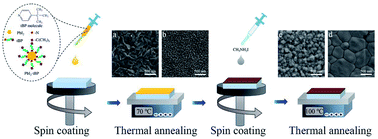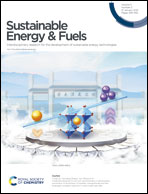Highly efficient and stable perovskite solar cells produced by maximizing additive engineering†
Abstract
The crystallinity of a perovskite film can play a key role in the photovoltaic performance and long-term stability of perovskite solar cells (PSCs). Herein, we introduce 4-tert-butylpyridine (tBP) into perovskite on the reduction-active poly(3,4-ethylenedioxythiophene):poly(styrenesulfonate) (PEDOT:PSS) hole transport layer and maximize its morphology-regulating effect via enhancing the concentration of CH3NH3I used in the two-step spin-coating. Since the high concentration iodine methylamine increases the oxidation potential, a perovskite film with large grains can be obtained. Furthermore, we proposed using a small amount of tBP with a high concentration of CH3NH3I and found that it would form a gradient structure in the perovskite. A small amount of tBP in CH3NH3I can further enhance its diffusion mobility into PbI2 films. Moreover, tBP in perovskite with a gradient structure can further induce coordination between tBP and perovskite, leading to considerably large perovskite grains (∼1.4 μm) with defect-free morphology. The perovskite grains can be more completely surrounded by the stronger hydrophobic tBP. Therefore, both the efficiencies and moisture stabilities of the PSCs can be significantly enhanced. PSCs without encapsulation could even maintain more than 80% of their initial PCE after 400 h of moisture exposure (RH ∼50%). Moreover, the flexible devices after optimization could achieve a PCE of 14.92%, and still maintain at 11.39% after 20 times of mechanical bending.



 Please wait while we load your content...
Please wait while we load your content...